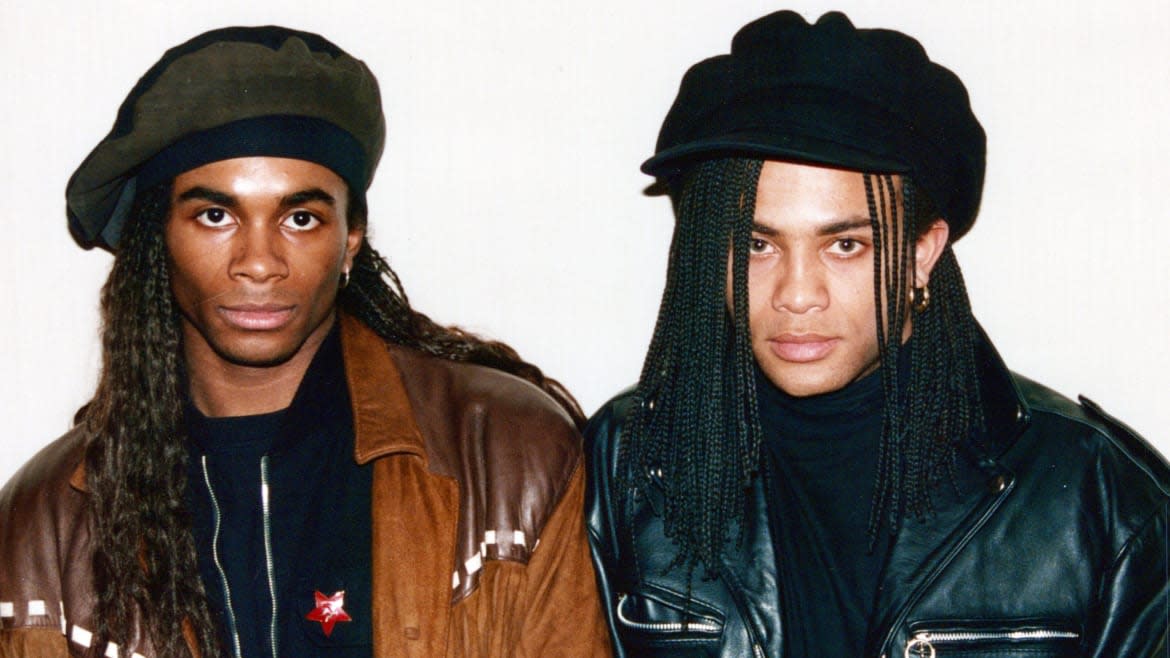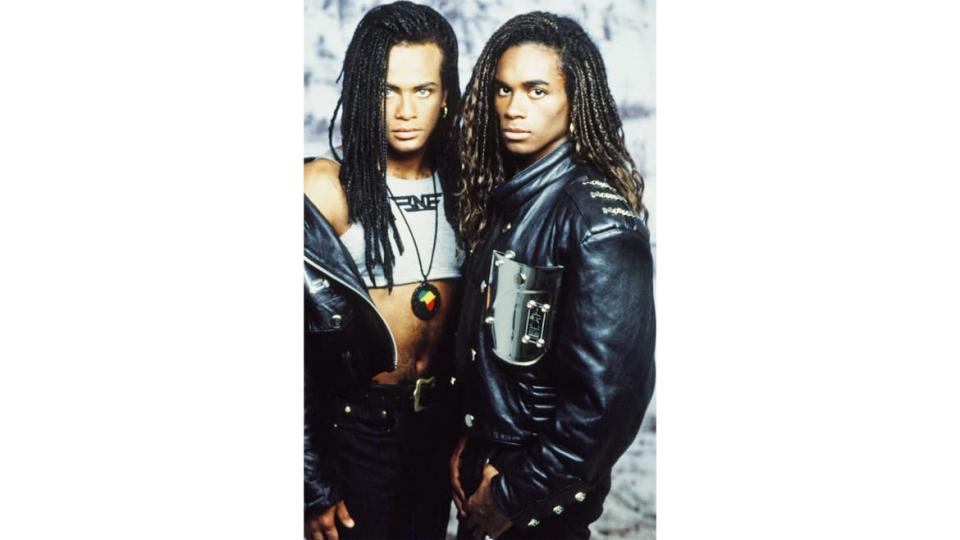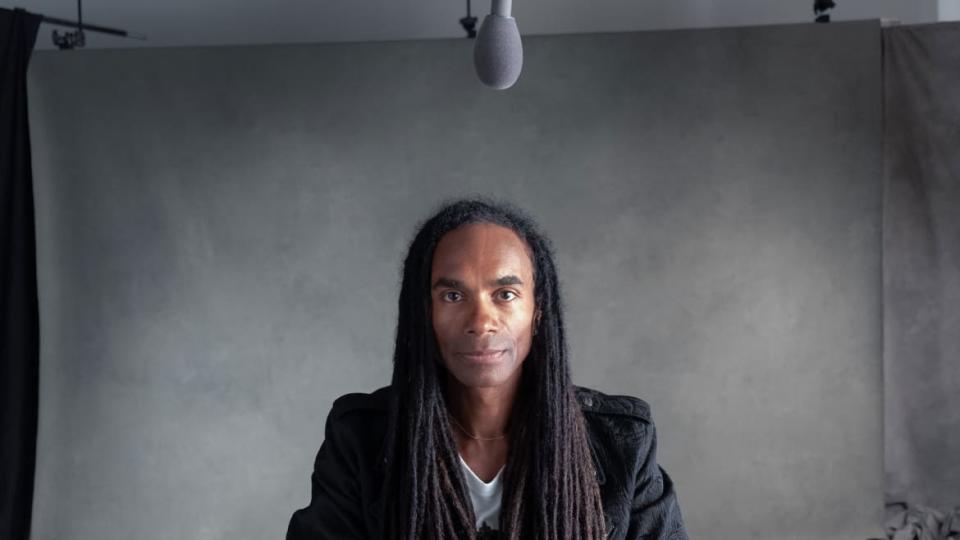How Milli Vanilli Embraced Pop Music’s Biggest Con

Satan is evil, but that doesn’t absolve people of willingly agreeing to Faustian bargains—a lesson hammered home by Milli Vanilli, a new Paramount+ documentary (Oct. 24) about the infamous singing duo whose rocket-ship ride to stardom wound up crashing and burning after they were outed as lip-syncing frauds.
Director Luke Korem’s feature-length film certainly spreads the blame around, beginning with producer Frank Farian and ending with Clive Davis, whom Arista Senior VP Ken Levy states was aware of Milli Vanilli’s phoniness. Nonetheless, no amount of deflection and feel-good platitudes can alter the fact that performers Fab Morvan and Rob Pilatus chose to go along with their deceitful scam out of an understandable—if far from exculpatory—desire to achieve their fortune-and-fame dreams, which peaked with a 1990 Grammy win for Best New Artist.
Rob and Fab’s saga is a cautionary tale about, as the former put it during their 1990 facing-the-music press conference, making “a pact with the devil.” However, Milli Vanilli doesn’t have much to reveal that isn’t by now well-known pop lore. Its biggest wannabe-bombshell is that industry legend Davis allegedly knew that Rob and Fab weren’t singing on their singles and albums and still accepted the ruse because their tunes kept topping the charts and their popularity continued to rise. That Davis didn’t seem to suffer a blow to his esteemed reputation for the scandal while Rob and Fab were humiliated and ruined—and Rob subsequently fell into drug addiction that cost him his life in 1998 at the age of 33—underscores the inequality at the heart of this tale. So too does Farian emerging relatively unscathed from this ordeal, and again perpetuating the same fraud by using phony artists to “perform” on a subsequent “The Real Milli Vanilli” LP.
Milli Vanilli paints an unflattering portrait of Farian as a talented artist who created groups led by Black men—first Boney M., then Milli Vanilli—to lip-sync his songs. Even so, that hardly gets Rob and Fab off the hook for their own predicament, and considerable commentary from Fab (who now lives happily in the Netherlands with his partner and four children) doesn’t alter the impression that they understood what they were getting into from the outset. Close friends from the moment they met at a party in Germany, Rob and Fab were bonded by broken childhoods, financial hardship, and a hunger to entertain. The parties they began throwing soon attracted the attention of Farian, who rightfully recognized that their look—long braids, colorful headbands, chiseled bodies—was as unique as their charisma was powerful.

Rob and Fab were excellent dancers, but they couldn’t sing, so Farian decided to have them serve as mannequin frontmen for a song he was already producing. The finished product was “Girl You Know It’s True,” which rapidly climbed the charts in Germany, Europe, and finally America, where it peaked at No. 2 on the Hot 100. Rob and Fab now had it all, and they apparently enjoyed it to the fullest, although it came at a steep cost, given that they had to carefully guard their deep, dark secret. In Milli Vanilli, Fab says that they signed their contract with Farian without reading it, and upon hearing that they were supposed to lip-sync to Brad Howell’s singing and Charles Shaw’s rapping on “Girl You Know It’s True,” they were both furious and yet acquiesced. Once the money began pouring in, the promotional spots became more frequent, and the U.S. tours (sponsored by MTV) took off, they were all in—this despite their knowledge that their con couldn’t last forever.
Cracks initially began materializing at a July 21, 1989 show in Bristol, Connecticut, where their vocal track got stuck in a loop. It wasn’t until after they won their Grammy, however, that the Milli Vanilli train raced off the tracks, thanks to Farian—in response to Rob trying to blackmail the producer into letting them sing on their follow-up record—publicly copping to his own trick. The fallout was swift and harsh, and Milli Vanilli trots out clips from news programs and late-night shows that castigated and mocked the duo for its deception. This resulted in Milli Vanilli returning their Grammy (a first) and going into veritable hiding following a disastrous press conference in which they fielded one hostile question after another. Fab receded into the show business background, while Rob sought refuge in drugs. In the film’s saddest moment, Fab recalls finding his former “brother” dazed and confused on the streets and returning him to his residence, which by all appearances was a crack house.

Milli Vanilli features interviews with many individuals involved in this story, including Farian’s assistant Ingrid Segieth, Arista executives Levy and Mitchell Cohen, Diane Warren (who’s barley questioned about her role in “Blame It on the Rain,” which she wrote), and Howell and Shaw, as well as a collection of music critics who describe the act’s astonishing early success and abrupt downfall. Unfortunately, it has little interest in digging beneath the surface, exemplified by the film relaying that the name Milli Vanilli came from Segieth, but not explaining precisely how. A few scattered remarks strive to cast Fab and Rob as victims of a predatory pop-music machine that used them and then discarded them, yet it remains clear that they were eager and cooperative puppets who were seduced by the high life earned by their dishonesty.
No matter its wider view of the forces at play in this tale, Milli Vanilli can’t strip Fab and Rob of their own agency in their disgrace. Which isn’t to say that they were nefarious villains who deserved the vitriol from fans and critics. Korem’s film argues that Milli Vanilli were simply the most blatant example of pop music’s inherent artificiality, and that their actions hurt no one but themselves. As critic Hanif Abdurraqib asks about this notorious late-’90s episode, “So fucking what?” It’s the most apt sentiment expressed in the entire doc, if also one that simultaneously renders the proceedings merely a nostalgic look back at a brief, sensationalistic, and ultimately unimportant blip in pop culture history.
Get the Daily Beast's biggest scoops and scandals delivered right to your inbox. Sign up now.
Stay informed and gain unlimited access to the Daily Beast's unmatched reporting. Subscribe now.

 Yahoo News
Yahoo News 
